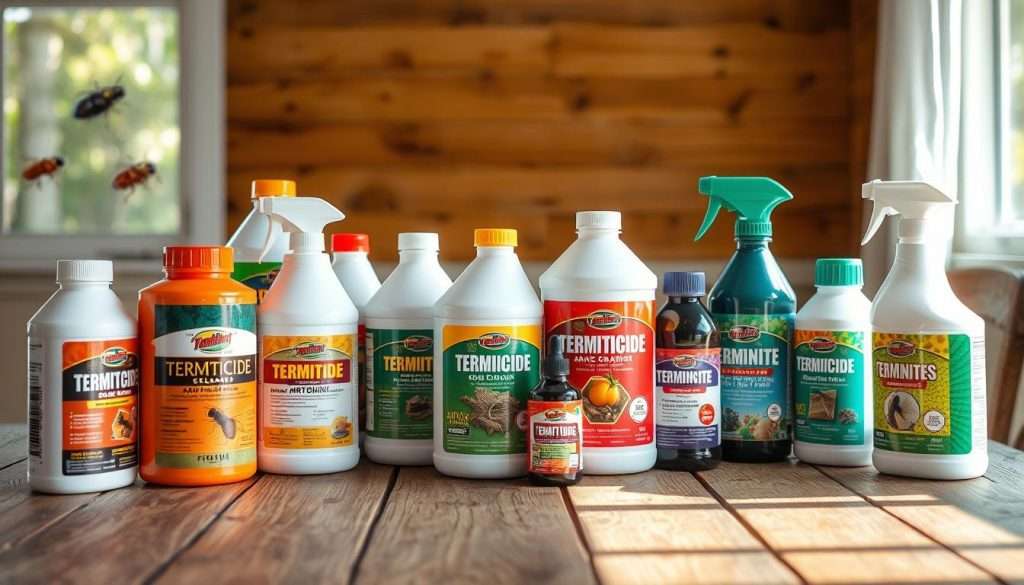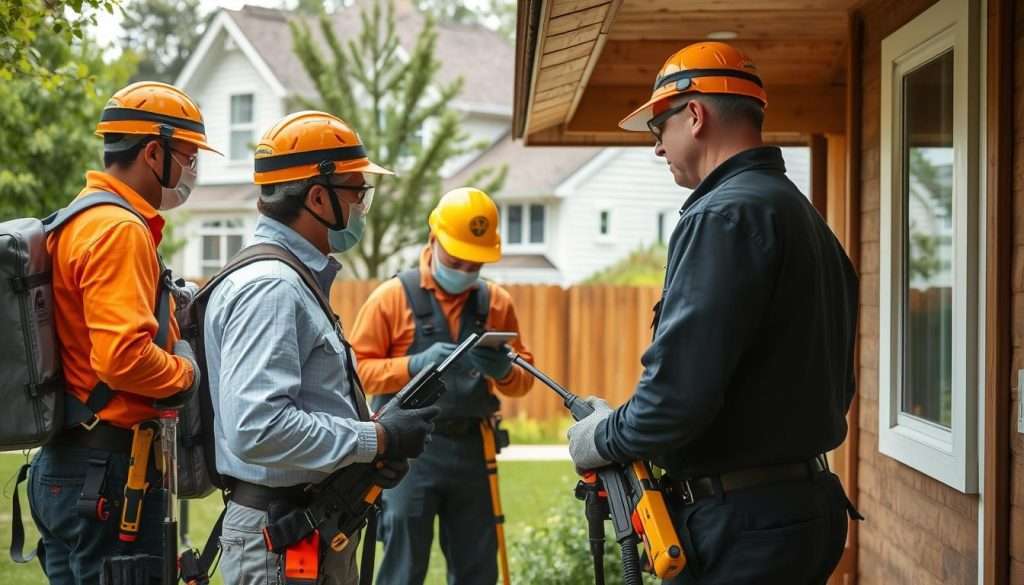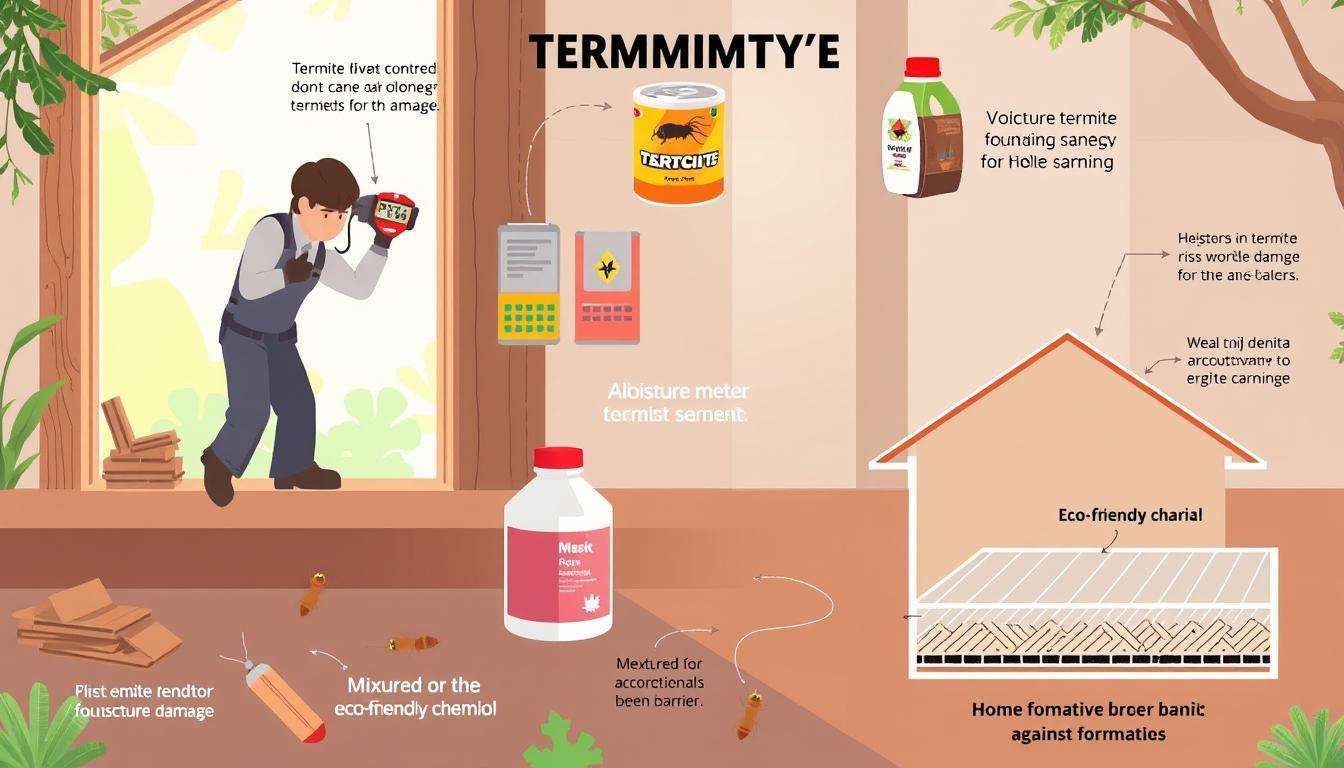Termite infestations are a big problem for homeowners in the United States. They cause about $30 billion in damages each year. If you’re worried about these pests, it’s important to know how to get rid of them.
Our guide will show you different termite extermination methods. You’ll learn about both professional and DIY ways to fight termites. We’ll help you understand the types of termites and the best termite control products to use. This way, you can protect your home from these wood-destroyers.
Key Takeaways
- Termites can cause enormous damage, costing homeowners billions each year.
- Liquid termiticides can create long-lasting barriers to protect your home.
- Early detection and regular inspections are crucial for effective termite management.
- Professional pest control services offer comprehensive solutions for severe infestations.
- DIY methods can be useful for minor termite issues, but understanding the problem is key.
- Preventive measures are essential to reduce future risk of infestations.
Understanding Termite Infestations
Termite infestations are a big worry for homeowners. They can cause a lot of termite damage. In the United States, about 600,000 homes get damaged by termites every year. This costs nearly $30 billion to fix.
To fight these pests, it’s important to know the types of termites and the damage they do.
The Damage Termites Cause
Termites eat wood and plant materials. They are a big threat to buildings. When they attack, they weaken wood, leading to:
- Structural weakness in buildings
- Collapse of wooden elements
- High repair costs, which can get even higher if not caught early
The signs of termite damage include wood that feels soft and might collapse. Finding these problems early can save a lot of money.
Types of Termites: Drywood and Subterranean
In North America, there are mainly drywood and subterranean termites. Each type has its own way of living and damaging wood:
| Type | Habitat | Characteristics |
|---|---|---|
| Drywood Termites | In dry wood within structures | Harder to detect, but can be treated with spot treatment or fumigation |
| Subterranean Termites | Underground | Build mud tubes; most destructive wood-damaging pests |
Both types of termites need certain places to live. Subterranean termites are usually more damaging because their colonies are huge. Knowing about these types of termites helps in finding the right ways to stop them.
How to Kill Termites: Effective Treatment Strategies
Dealing with termites needs a mix of methods to get rid of them for good. There are quick fixes and long-term plans. Homeowners can use special termiticides, treatments, and products to fight these pests.
Liquid Termiticides: Rapid Solutions
Liquid termiticides like Taurus SC and Dominion 2L work fast. They make a barrier that keeps termites out of wood. Putting these around your home’s edges can lower infestation risks.
To apply, dig a trench, inject the liquid, and seal it up. This keeps the barrier strong.
Termite Baiting Systems: Long-term Control
Baiting systems like Sentricon® are good for long-term control. They target the termite queen. Stations around your home attract termites, offering ongoing control.
This method is great for:
- Long-term prevention.
- Finding active colonies.
- Less harm to the environment.
Additional Treatment Methods
Other products can also help. Spot treatments with foams or dusts reach hidden spots. They’re useful for:
- Local infestations.
- Quick fixes in hard-to-reach places.
Using different treatments together can keep termites away. Regular checks and upkeep make these methods even better.

Identifying Signs of Termite Infestation
It’s key for homeowners to spot termite signs early. Catching them early can lessen damage. Knowing the signs helps you defend your home well. If you see any of these signs, act fast.
Common Indicators of Infestation
Here are signs of termite infestation:
- Mud tubes: These structures along foundation walls show active infestation.
- Hollow-sounding wood: Wood that sounds hollow when tapped might have termites.
- Swarmers: Seeing many winged termites near lights means a colony is close.
- Termite droppings: BB-sized pellets on surfaces hint at drywood termites.
- Pinholes: Small mud spots on walls might mean termites are there.
- Swarm castles: Odd mud shapes on walls in late spring could mean Formosan termites.
For more on identifying termite signs, check out expert guides or reliable sources.
The Importance of Early Detection
Finding termites early is crucial to avoid big damage. Regular checks by pros help keep your space termite-free. If you see damage or signs, call a pest control expert.
It’s also key to prevent termites. Regular checks, especially in risky spots, stop infestations. Keep your home safe by checking its structure often and watching for odd changes.
Professional vs. DIY Termite Treatment
Homeowners must decide between professional termite services and DIY termite elimination. Each choice has its pros and cons. Knowing these can help you choose the best option for your situation.
Pros and Cons of Professional Pest Control
Professional pest control offers detailed solutions. Here are some key points:
- Expertise and Tools: Professionals use special knowledge and tools to fight infestations.
- Comprehensive Inspections: They find and fix problems all over your property.
- Safety: They use safe treatments, even when you have kids or pets.
- Guaranteed Results: Many services promise results and offer warranties.
- Higher Costs: Professional services cost more than DIY at first.
- Long-term Savings: Saving money in the long run by avoiding big damage costs.
Recommended DIY Methods for Homeowners
DIY termite elimination is a good choice for those on a tight budget. Here are some methods:
- Liquid Termiticides: Liquid treatments can protect your home.
- Baiting Systems: These systems attract termites to bait stations.
- Preventive Measures: Using termite-resistant materials can protect your home long-term.
- Immediate Action: DIY methods let you act fast, especially in early infestations.
DIY methods can save money but take more time and effort. They might not work as well for big infestations. DIY often only fixes surface problems, letting hidden termites grow.
Choosing between professional services and DIY depends on your budget, skills, and the infestation’s size. For big problems, professionals are usually the best choice.

| Aspect | Professional Services | DIY Methods |
|---|---|---|
| Cost | Higher upfront cost | Lower upfront cost |
| Expertise | Specialized knowledge and experience | Requires personal research and learning |
| Effectiveness | Comprehensive and often more thorough | May only address surface issues |
| Safety | Safe treatments for home environments | Varies; research needed for safety |
| Time Investment | Less time-consuming; experts manage the process | Can be labor-intensive and time-consuming |
Preventing Future Termite Infestations
Every homeowner should take steps to prevent termite infestations. By using good termite prevention strategies, you can protect your home. This includes reducing wood-to-ground contact, ensuring good ventilation, and getting regular checks from pest control experts.
Effective Termite Prevention Strategies
To keep your home safe from termites, try these tips:
- Reduce wood-to-ground contact by elevating wooden structures and landscaping.
- Seal cracks, crevices, and joints in exterior wood to deter entry points for termites.
- Apply a fresh coat of paint to wooden surfaces, which can help seal small crevices.
- Remove dead trees and firewood, as these attract drywood termites.
- Avoid water pooling near the foundation, which can draw termites towards your home.
Importance of Regular Inspections
Regular inspections are key to preventing termites. It’s smart to get annual checks from pest control experts. This early detection lets you act fast to stop damage. Regular checks also give you peace of mind and keep your home strong. Here’s why regular inspections are important:
| Benefit | Description |
|---|---|
| Early Detection | Identifies termite activity before significant damage occurs. |
| Tailored Treatment Plans | Allows pest control experts to formulate customized strategies. |
| Continued Protection | Makes it easier to implement ongoing maintenance and treatment options. |
| Peace of Mind | Ensures homeowners feel secure about the condition of their property. |
Conclusion
Knowing how to kill termites is key for homeowners to protect their homes. We’ve looked at different types of termites, like subterranean and drywood. These pests can grow fast and harm your home’s structure.
We’ve talked about ways to control termites, from liquid treatments to baiting systems. Some methods you can do yourself, but for big problems, you might need a pro. Regular checks can help find issues early.
By using what we’ve learned, you can handle termite problems in your home. Keep an eye out, do regular checks, and act fast. This can prevent expensive repairs later on.
